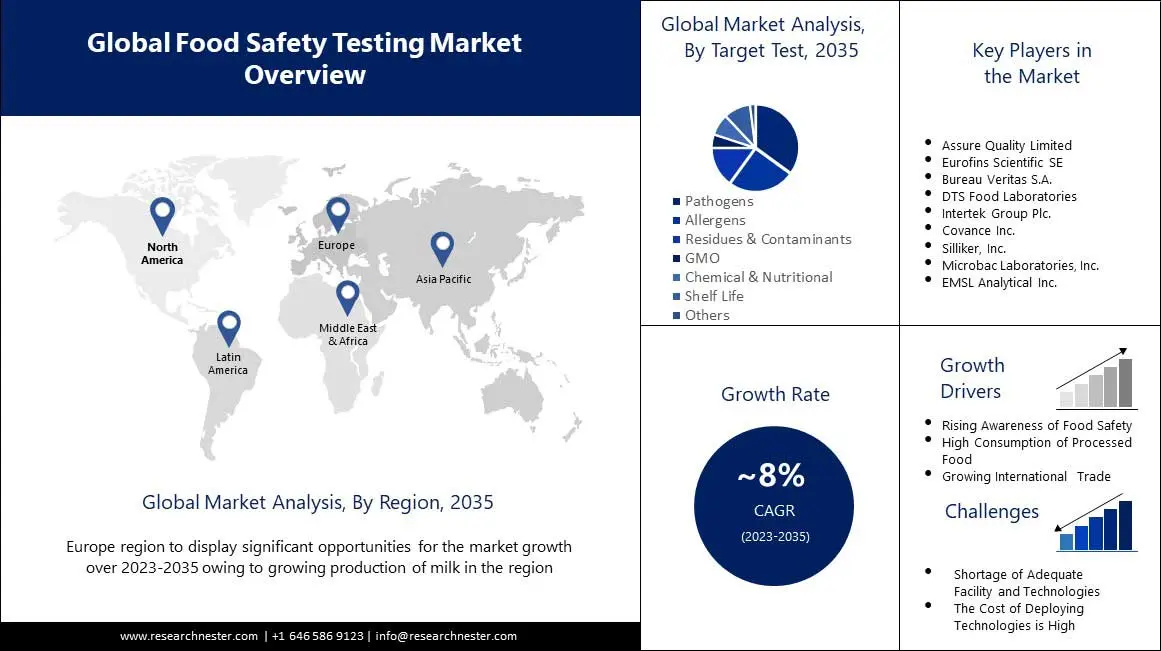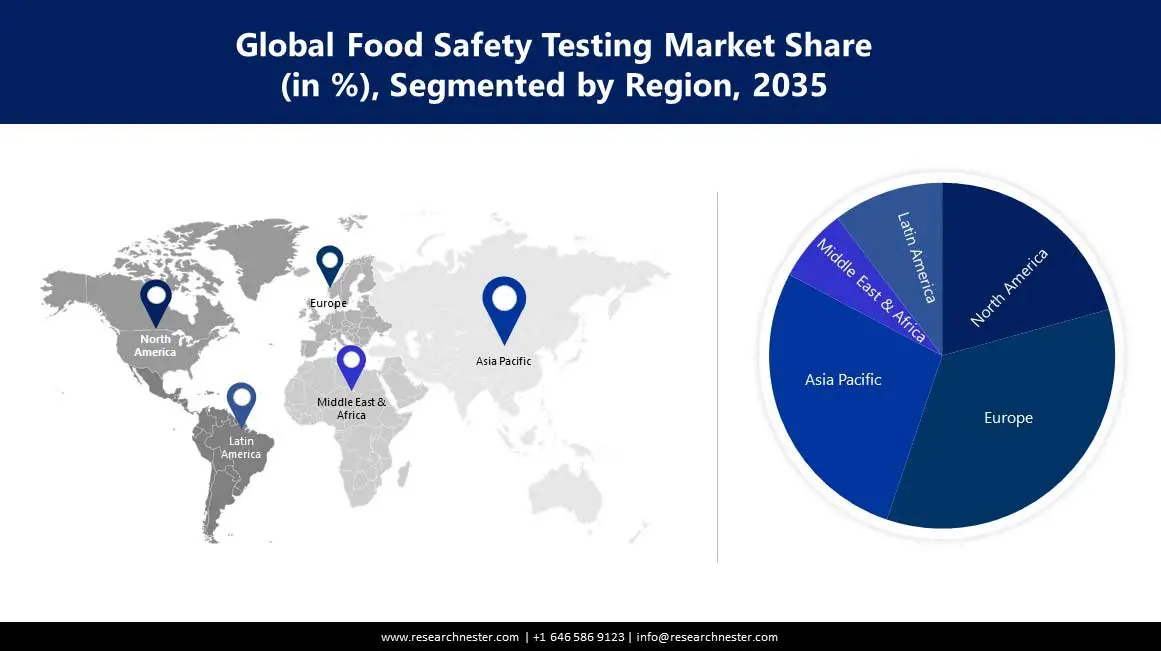
Food Safety Testing Market size is estimated to surpass USD 50 Billion by the end of 2035, growing at a CAGR of 8% during the forecast period i.e., 2023-2035. In the year 2022, the industry size of food safety testing was over USD 20 Billion.The growth of the market can be attributed to the increasing number of people concerned about food quality and safety. A study of around 8500 people in different nations, including Australia, Brazil, China, France, India, Nigeria, Pakistan, Russia, and the United States that around 60% of people were concerned about the sanitary and safety of the food they purchase and they believe that food safety is equal to a healthy life. This is especially true in China, where 80% of respondents associated safe food with being healthy.
In addition to these, factors that are believed to fuel the market growth of food safety testing include the rising cases of foodborne illness and the increasing sensitivity of people towards food. Food safety testing is essential for identifying the allergen component in the product as well as to increase the shelf life of the final product to reduce the attack of the pathogen. Food allergies are becoming more common worldwide and can be exceedingly dangerous, even fatal. Around one in every four persons who are unfortunate enough to develop a food allergy, no matter how mild, are expected to eventually have a serious reaction. Moreover, from around 1,015 admissions in 2013 to nearly 1,746 entries in 2019, the number of hospital admissions for children due to anaphylaxis caused by food increased by approximately 72% in England.

Growth Drivers
Challenges
|
Base Year |
2022 |
|
Forecast Year |
2023-2035 |
|
CAGR |
~8% |
|
Base Year Market Size (2022) |
~ USD 20 Billion |
|
Forecast Year Market Size (2035) |
~ USD 50 Billion |
|
Regional Scope |
|
Application (Dairy Products, Bakery & Confectionary, Processed & Packages Food, Infant Food, Functional Food, Meat & Poultry Products, Alcoholic & Non-Alcoholic Beverages, Seafood)
The global food safety testing market is segmented and analyzed for demand and supply by application into dairy products, bakery & confectionary, processed & packages food, infant food, functional food, meat & poultry products, alcoholic & non-alcoholic beverages, and seafood. Out of the eight applications of food safety testing, the meat & poultry segment is estimated to gain the largest market share in 2035. The growth of the segment can be attributed to the rising production of meat and poultry. Food safety testing is consequently essential for meat and poultry owing to their potential for harm if handled poorly, as raw meat, lab-grown meat, and eggs are referred to as high products. Over 86 million eggs were produced in 2021, and 87 million in 2021 across the globe. The volume of eggs produced globally has increased by more than 100% since 1990. In addition to this, according to the OECD-FAO Agricultural forecast the world's meat supply would increase and probably reach 374 Mt by 2030. Increased productivity per animal and extension of the herd and flock are projected to be the majority in the Americas and China.
Target Test (Pathogens, Allergens, Residues & Contaminants, GMO, Chemical & Nutritional, Shelf Life)
The global food safety testing market is also segmented and analyzed for demand and supply by target test into pathogens, allergens, residues & contaminants, GMO, chemical & nutritional, shelf life, and others. Amongst these seven segments, the pathogens segment is expected to garner a significant share in the year 2035. Food testing is mainly done to ensure any sort of pathogen attack on the food. Sometimes in contaminated food, pathogens are accidentally consumed along the food as it creates a toxin when sits for a longer period on a food. Moreover, the pathogen can also cause foodborne diseases in the human host. The segment growth is mainly expected on the account of foodborne illness causes by pathogens and its adverse effects on socio-economic conditions. The World Health Organization asserts that foodborne illnesses hinder socioeconomic growth by damaging international trade, tourism, and country economies. Moreover, it also put a strain on the healthcare system. In low- and middle-income nations, unhealthy food costs USD 110 billion annually in lost productivity and medical costs.
Our in-depth analysis of the global market includes the following segments:
|
By Technology |
|
|
By Target Test |
|
|
By Application |
|
Europe Market Forecast
The European food safety testing market, amongst the market in all the other regions, is projected to hold the largest market share of around 31% by the end of 2035. The growth of the market can be attributed majorly to the rising production of milk in the region. Nutritional labeling is important for the milk, for which food testing is done on the composition of the milk at various stages to guarantee fat management and identity requirements are met. According to Eurostat, in 2021, the European Union generated 161 million tons of raw milk. Additionally, in 2021, the average apparent milk yield per cow in the EU was 7,682 kg. Furthermore, the diet of Europeans includes a significant amount of seafood as a source of their protein. Therefore, market growth is also expected on the account of high consumption of seafood. The average European consumes about 3.3 kg more fish or seafood than the rest of the globe, or about 24 kg each year. Moreover, the most consumed seafood is salmon, tuna, and cod.
APAC Market Statistics
The Asia Pacific food safety testing market, amongst the market in all the other regions, is projected to hold the second largest share of nearly 23% during the forecast period. The growth of the market can be attributed majorly to the increasing cases of foodborne illness. In China, poisonous mushrooms continue to be a serious issue, as they were responsible for the majority of outbreaks and fatalities this past year. There was a total of around 7,000 foodborne outbreaks in 2020, which led to nearly 37,000 illnesses and about 143 fatalities. In addition to this, in India, every year around 100 million foodborne illnesses, and nearly 120,000 foodborne illness-related fatalities are reported. Moreover, around 8 million people lose their life after a prolonged disability caused by foodborne illness.
North American Market Forecast
Further, the market in North American, amongst the market in all the other regions, is projected to hold a significant share of 19% by the end of 2035. The growth of the market can be attributed majorly to the increasing prevalence of food allergies. By 2021, there were roughly 20 million food-allergic Americans, of which 16 million are adults and the remaining 4% are children. Moreover, in the same year, almost 1 million persons in the United States were identified as being severely allergic to sesame. Besides this, among children, milk stands as the top allergic food followed by peanuts and eggs. Furthermore, the rising consumption of meat and poultry, and processed food is also expected to boost the market growth in the region. In 2021, around 30 billion pounds of beef were consumed in the United States



Intertek Group Plc. announce the acquisition of Brasil Laboratório de Análises de Alimentos S.A, a leading food testing company. Through this acquisition, Intertek plans to expand its reach into the agri-food & beverage market in Brazil and enable end-to-end Total Quality Assurance (TQA).
Eurofins Scientific SE a leading player in the food testing industry has signed a contract to sell its Digital Testing division to Stirling Square Capital Partners ("Stirling Square") for USD 234 million in cash and debt-free terms.
Author Credits: Anil Kumar, Ipsheeta Dash
Copyright © 2024 Research Nester. All Rights Reserved

FREE Sample Copy includes market overview, growth trends, statistical charts & tables, forecast estimates, and much more.
Have questions before ordering this report?